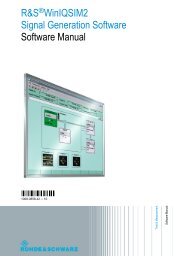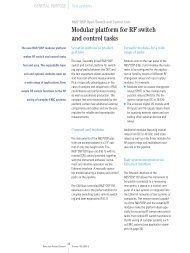News from Rohde&Schwarz - Rohde & Schwarz
News from Rohde&Schwarz - Rohde & Schwarz
News from Rohde&Schwarz - Rohde & Schwarz
Create successful ePaper yourself
Turn your PDF publications into a flip-book with our unique Google optimized e-Paper software.
<strong>News</strong>grams<br />
<strong>Rohde</strong> & <strong>Schwarz</strong> faculty<br />
award 1999<br />
As in recent years, the Day of<br />
the Faculty of Electrical Engineering<br />
and Information Technology<br />
held at the Technical University<br />
in Munich again formed a fitting<br />
background for the <strong>Rohde</strong> &<br />
<strong>Schwarz</strong> faculty award<br />
ceremony. COO Hans Wagner<br />
presented the award this time<br />
round to Dr.-Ing. Christian Legl<br />
(photo).<br />
In his thesis, Dr Legl investigated<br />
field-programmable gate arrays<br />
(FPGAs) and developed a highly<br />
efficient technique for their<br />
logical synthesis, which received<br />
a lot of attention in specialist circles.<br />
In his speech, Hans Wagner<br />
underlined the importance of<br />
Dr Legl’s contribution especially<br />
for companies like <strong>Rohde</strong> &<br />
<strong>Schwarz</strong>, where FPGAs are used<br />
as economical solutions for<br />
medium-batch applications.<br />
The world’s first portable crystal clock<br />
returns home to <strong>Rohde</strong> & <strong>Schwarz</strong> museum<br />
In brief<br />
In 1972, when the Olympic Games<br />
were held in Munich (summer) and<br />
Sapporo (winter), the two cities<br />
decided to twin. As a result Sapporo<br />
organized an exhibition of representative<br />
products <strong>from</strong> the city of Munich.<br />
The mayor of Munich invited important<br />
companies of his city to participate,<br />
and <strong>Rohde</strong> & <strong>Schwarz</strong> offered –<br />
as a historical milestone in measurement<br />
technology – its crystal clock developed<br />
in 1936.<br />
The world's first<br />
portable crystal<br />
clock returns home<br />
<strong>from</strong> Sapporo to<br />
Munich. Dr Matthias<br />
Ludwig, <strong>Rohde</strong> &<br />
<strong>Schwarz</strong>, expresses<br />
his gratitude to the<br />
director general of<br />
economic affairs of<br />
the city of Sapporo,<br />
Noboru Takahashi<br />
(center)<br />
The instrument was the world’s first<br />
portable crystal clock and reference<br />
signal generator. The crystal clock was<br />
accurate to 0.004 seconds per day,<br />
and the reference signal generator to<br />
1x10 –7 per day between 1 kHz and<br />
100 kHz. Because of its extremely<br />
high accuracy, it was widely used<br />
around the world as a time standard.<br />
For <strong>Rohde</strong> & <strong>Schwarz</strong>, and in particular<br />
for Dr <strong>Schwarz</strong>, one of the two<br />
founders of the company, the instrument<br />
meant a great deal, as it was<br />
by far the most popular product during<br />
the starting years of the company.<br />
The clock, which had since been displayed<br />
in the Access Sapporo, the<br />
new event hall, together with other<br />
products of the city of Munich, has<br />
now been returned. It will in future<br />
be exhibited again in the Measuring<br />
Instruments Museum of <strong>Rohde</strong> &<br />
<strong>Schwarz</strong>.<br />
Akihiko Yoshimura<br />
ADVANTEST<br />
Neues von <strong>Rohde</strong> & <strong>Schwarz</strong> Heft 164 (1999/IV) 37

















